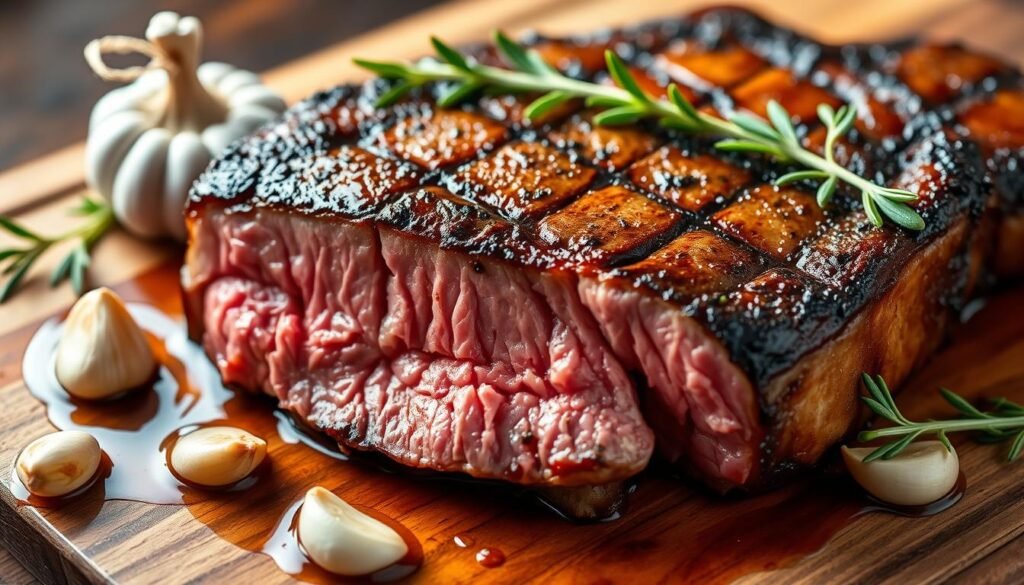Did you know filet mignon is the most tender beef cut? It’s loved for its soft texture and deep flavor. In the U.S., over 25 million filet mignon steaks are eaten every year. If you want to cook filet mignon perfectly, you’re in the right spot. This guide will teach you everything, from cuts to cooking methods at home. It’s perfect for both experienced chefs and beginners.
Key Takeaways
- Filet mignon is renowned for its tenderness and flavor, making it a popular choice in upscale dining.
- Understanding the history and different cuts of filet mignon can enhance your cooking experience.
- Choosing quality meat and recognizing the importance of marbling is crucial for delicious results.
- Proper seasoning and cooking techniques transform a good steak into an extraordinary meal.
- Pairing filet mignon with the right sauces and side dishes elevates your presentation.
- Leftover filet mignon can be creatively repurposed in various recipes.
What is Filet Mignon?
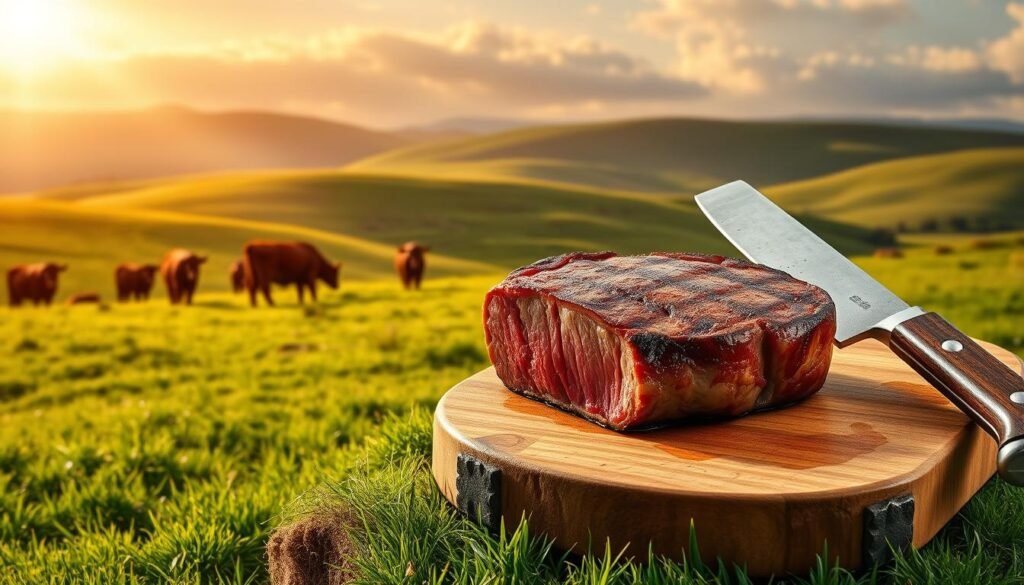
Filet mignon is a tender cut of beef, prized for its softness. It comes from the tenderloin, near the spine. This makes it a favorite among steak fans.
Its history is rich, tracing back to France’s early culinary days. Knowing this history adds to the joy of eating it.
A Brief History of Filet Mignon
The tale of filet mignon spans centuries, growing with cooking arts. In French cuisine, it became a top choice, served at fancy restaurants. Its tenderness made it a hit with foodies.
Today, it’s still seen as elegant and sophisticated.
Different Cuts of Filet Mignon
There’s a term, “center-cut,” for the most tender parts. Filet mignon can be served whole or cut into medallions. Each way has its own appeal.
Flavor Profile and Texture
Filet mignon’s taste is mild, with less fat than other beef. Its tenderness is unmatched, melting in your mouth. The juiciness is enhanced by various seasonings and cooking styles.You can learn more about how to cook ribs in the oven.
Choosing the Right Filet Mignon
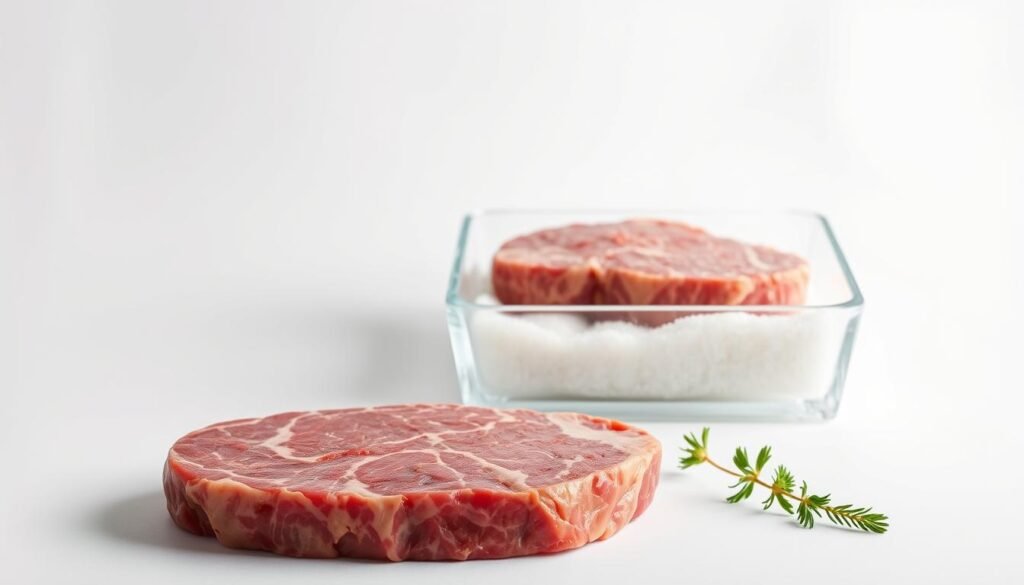
Choosing the right filet mignon is key to a great meal. A good cut can make your meal tender and flavorful. I look at color, firmness, and fat-to-meat ratio when picking. These factors affect the steak’s taste and texture.
How to Select Quality Meat
When I look for quality filet mignon, I check a few things:
- Color: A bright, deep red color means it’s fresh.
- Firmness: Press the steak gently; it should feel firm but spring back.
- Fat distribution: Even fat throughout makes the steak taste better and feel tender.
These signs mean you’ve got a high-quality cut for a great meal.
Fresh vs. Frozen Fillets
Fresh vs frozen steak has its pros and cons. Fresh steak usually tastes better and feels more tender. But frozen steak can be convenient and still taste good, thanks to new freezing methods.learn more about how to cook chiken breast.
The Importance of Marbling
Marbling is crucial in filet mignon. The fat in the meat melts when cooked, making it juicy and flavorful. A steak with good marbling is more enjoyable to eat, with each bite being tender and tasty.
Preparing Filet Mignon for Cooking
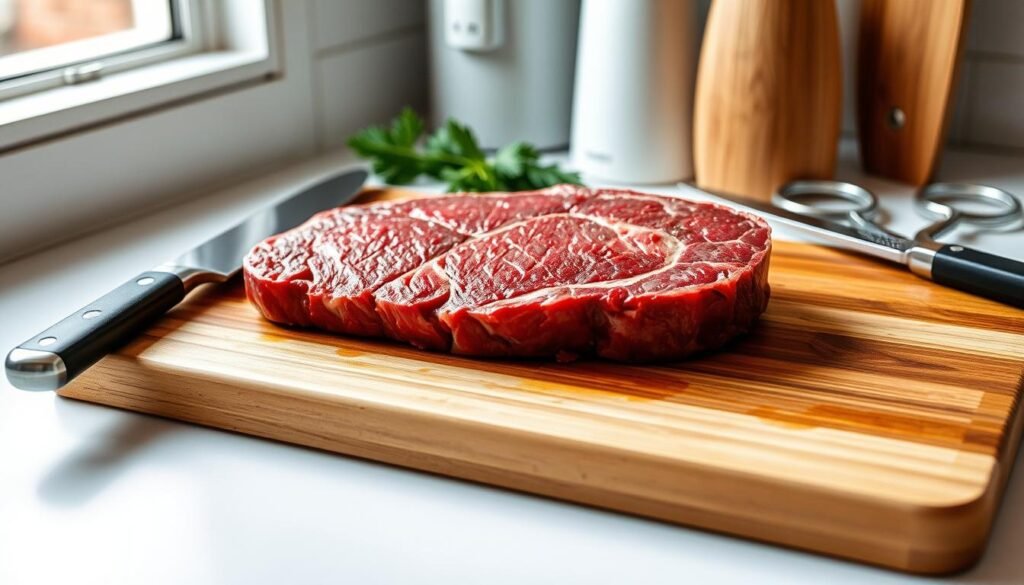
Preparing filet mignon requires attention to detail. It starts with thawing the steak right and continues with trimming and seasoning. Let’s explore each step for the best results.
Thawing Frozen Steak Properly
Thawing steak is key to keeping its texture. The best way is to thaw it in the fridge for about 24 hours. If you’re in a hurry, thaw it in cold water for a few hours. But, avoid microwaving as it can mess up the meat.
Trimming and Cleaning the Meat
Trimming the filet mignon is important. It removes silver skin and excess fat, improving taste and look. Use a sharp knife for clean cuts. Then, rinse the meat under cold water and pat it dry with paper towels.
Seasoning Options
For seasoning, I keep it simple to let the meat’s flavor shine. A mix of kosher salt and black pepper is great. You can also add fresh herbs like rosemary or thyme. Or, try a marinade with olive oil, garlic, and spices for extra flavor.
| Thawing Method | Time Required | Advantages |
|---|---|---|
| Refrigerator | 24 hours | Retains texture, consistent temperature |
| Cold Water | 2 hours | Faster than refrigerator |
| Microwave (not recommended) | Varies | Risk of uneven cooking and texture loss |
Cooking Methods for Filet Mignon
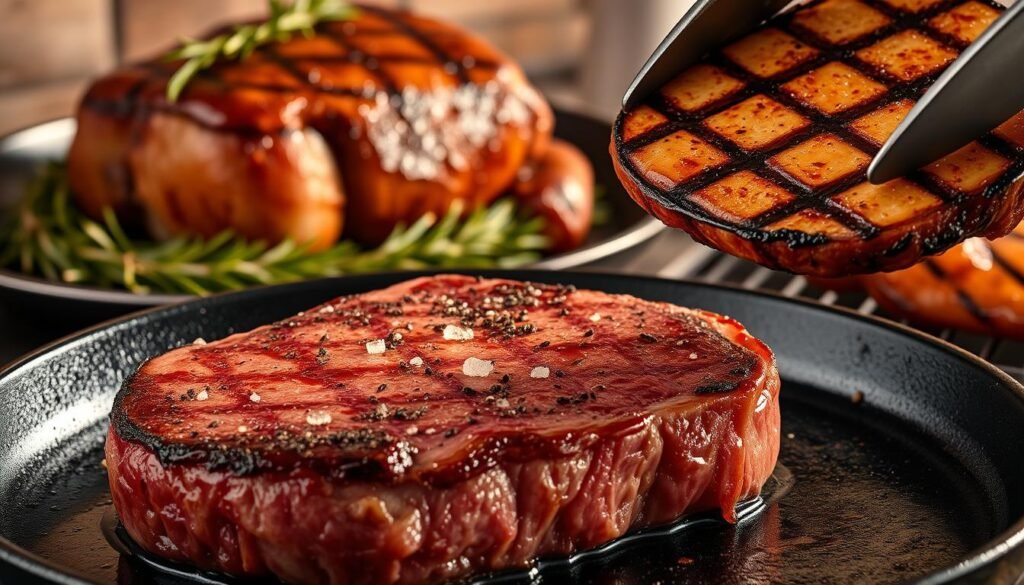
Preparing filet mignon can be exciting with a few top methods. These methods highlight the meat’s juicy flavor and tender texture. Let’s dive into grilling, pan-searing, and oven roasting to find your favorite way to cook.
Grilling Filet Mignon to Perfection
Grilling adds a smoky taste and a beautiful sear. First, heat your grill well and oil the grates to avoid sticking. Use high heat and place the filets on the hottest spot. Cook for 4-5 minutes on each side for a medium-rare. Let it rest to keep it juicy.
Pan-Searing Techniques
Pan-searing makes a delicious crust that keeps juices in. Use a heavy skillet and heat it over medium-high. Add oil and cook the seasoned filet for 3-4 minutes on each side. Then, lower the heat and cook a bit longer to your liking. Adding butter at the end boosts flavor and richness.learn more about how to cook scallops.
Oven Roasting: A Step-by-Step Guide
Oven roasting infuses flavor all the way through. Start by searing the filet in a hot skillet. Then, put it in a 400°F oven. Roast for 10-15 minutes, depending on the thickness. A meat thermometer ensures the perfect doneness.
| Cooking Method | Time (Minutes) | Flavor Profile |
|---|---|---|
| Grilling | 8-10 | Smoky with charring |
| Pan-Searing | 7-8 | Rich, caramelized crust |
| Oven Roasting | 10-15 | Evenly cooked with herbal infusion |
Cooking Temperature and Time
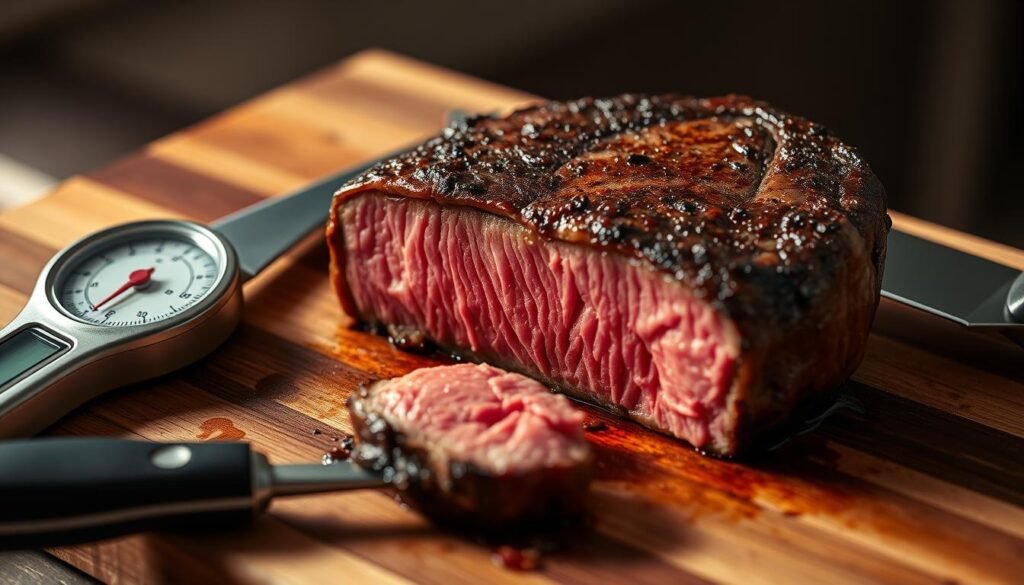
Mastering the cooking temperature for filet mignon is key to a perfect steak. Knowing the right internal temperature for each doneness level can make any meal better. A meat thermometer makes sure your steak is cooked just right, without any guesswork.
Understanding Meat Temperature Ranges
Understanding the different meat temperature ranges is crucial for cooking filet mignon perfectly. Here are the general guidelines for doneness:
| Doneness Level | Temperature (°F) | Texture Description |
|---|---|---|
| Rare | 125 | Soft and cool center |
| Medium Rare | 135 | Warm red center |
| Medium | 145 | Warm pink center |
| Medium Well | 150 | Hot, slightly pink center |
| Well Done | 160+ | Hot and fully cooked |
Tips for Perfectly Cooked Steak
To get the perfect steak, avoid common mistakes. Here are some tips:
- Always preheat your grill or skillet before cooking.
- Let your steak come to room temperature before placing it on the heat.
- Aim to remove the steak from heat when it is about 5 degrees below your target temperature. It will continue to cook while resting.
Using a Meat Thermometer
A meat thermometer is a must-have in your kitchen. Insert it into the thickest part of the filet mignon, avoiding bone or fat. This gives you an accurate reading. It helps you avoid overcooking and ensures a delicious meal every time.
Searing Techniques for Flavorful Crust
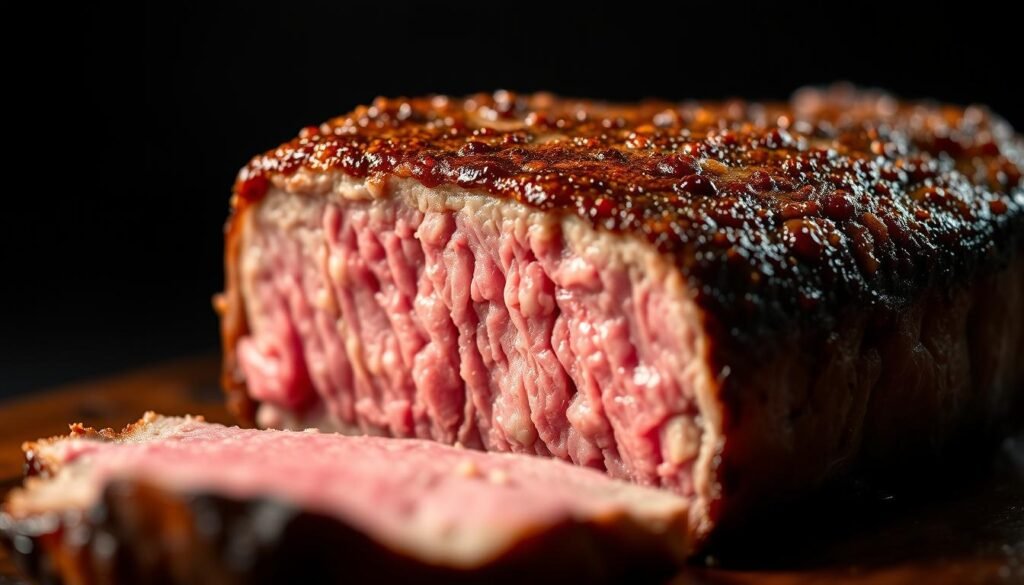
Searing filet mignon is key to a delicious steak. It uses high heat to create a tasty crust through the Maillard effect. This effect changes the meat’s proteins and sugars into rich flavors.
Adding butter basting and fresh herbs can make your steak even better. It takes your steak experience to a new level.
The Science of Searing
Searing means cooking the meat’s surface at high heat. It creates a delicious, caramelized crust that keeps the meat moist. To get the perfect sear, use a hot pan or grill and cook briefly.
Preheat your cooking surface well. This ensures the steak sears right away.
Butter Basting: Adding Richness
Butter basting steak is a favorite technique of mine. It adds richness and helps create a flavorful crust. As the butter melts, it makes a tasty sauce.
Spreading this sauce over the steak adds flavor and moisture. Adding herbs like thyme or rosemary makes it even more special.
Using Herbs for Extra Flavor
Fresh herbs like rosemary, thyme, and garlic are great with filet mignon. They add extra aroma and taste. Tossing herbs in the hot pan while searing infuses the meat with their flavors.
Resting Your Filet Mignon
Many people often overlook the importance of resting when cooking filet mignon. It’s crucial for a tender and flavorful steak. During this time, juices spread out, making the meat taste better and feel softer. Knowing this can really improve your cooking.
Why Resting Matters
Resting is very important. When a steak cooks, proteins tighten and juices move to the center. Resting lets these proteins relax and juices return to the meat. This makes the steak juicier and more flavorful.
How Long to Rest the Steak
The resting time varies based on the steak’s thickness. A 1-inch thick steak usually needs about 5 minutes. This short time is enough for the meat to be perfectly juicy and tender.
What Happens During Resting
While resting, the steak continues to cook slightly. This is called carryover cooking. It can increase the steak’s internal temperature a bit. Different doneness levels will have different temperatures after resting:
| Level of Doneness | Temperature Range (°F) |
|---|---|
| Rare | 120°F to 125°F |
| Medium Rare | 125°F to 130°F |
| Medium | 135°F to 140°F |
| Medium Well | 145°F to 150°F |
| Well Done | 155°F to 160°F |
For more details on preparing filet mignon, check out this helpful resource. Emphasizing the importance of resting will help you serve a steak that is not only visually appealing but also mouthwateringly delicious.
Sauces and Condiments for Filet Mignon
Filet mignon is amazing on its own, but the right sauces can make it even better. Pairing it with flavorful sauces can impress everyone at the table. I love trying out different sauces, from classic to homemade.
Classic Sauces to Try
Béarnaise and peppercorn sauces are timeless choices. Béarnaise is rich and buttery, with herbs that match the filet’s flavor. Peppercorn sauce adds a kick with its creamy texture and peppercorns. Both are great for a memorable meal.
Homemade Compound Butters
Making compound butter steak is a great way to add flavor. Mix softened butter with herbs, garlic, or blue cheese. It’s a simple way to make each bite taste amazing.
Wine Reduction Sauce Recipe
A wine reduction sauce is elegant and easy to make. Start with two cups of red wine and reduce it to concentrate the flavors. Add four tablespoons of salted butter for creaminess. This sauce is perfect with filet mignon. For more sauce ideas, visit this link.
Side Dishes to Pair with Filet Mignon
Creating a memorable meal with filet mignon goes beyond just the steak. The right side dishes can make the meal even better. They add flavor and elegance to your plate. Let’s look at some great vegetable pairings, starch options, and wines that go well with filet mignon.
Elegant Vegetable Options
Choosing vegetables for filet mignon is key. I like to pick elegant options that make the dish stand out. Oven-roasted brussels sprouts or stir-fried asparagus add color and crunch. A baby kale salad with honey balsamic vinaigrette adds a refreshing contrast. These sides not only taste great but also look good on the plate.
Perfect Wine Pairings
Choosing the right wine for steak can make the meal even better. A full-bodied Cabernet Sauvignon is a classic choice that pairs well with filet mignon. If you prefer something lighter, a smooth Merlot is a great option. Remember, the best wine is one you enjoy, so choose based on your taste.
Starch Sides: Potatoes and Beyond
Starch sides can be the real stars of the meal. Twice-baked potatoes are creamy and indulgent. Smashed potatoes with garlic and herbs are comforting and pair well with the meat. For something different, try gourmet Gruyere cheese grits for a rich, creamy texture. For more ideas, check out this list of side dishes for filet.
Serving Suggestions for Filet Mignon
When serving filet mignon, how you present it is key. It can make the meal unforgettable. I focus on presentation tips for steak to make each plate look as good as it tastes.
Presentation Tips for Gourmet Appeal
I start by adding creamy garlicy parmesan mashed potatoes on one side. Then, I add a spoonful of red wine mushrooms on top. This adds flavor and texture.
Next, I place the filet mignon alongside. It looks great and contrasts the textures. A sprinkle of chopped parsley adds a gourmet touch.
How to Carve Filet Mignon Properly
Carving steak right is crucial for its juiciness and look. I keep the steak whole until serving. This keeps it warm longer.
When carving, I slice against the grain. This makes the steak tender and flavorful. These steps help me serve filet mignon perfectly, impressing my guests.
For more tips on a great filet mignon dinner, check out this guide on cooking filet mignon.
Leftover Filet Mignon Ideas
Leftover filet mignon is a great chance to make new, tasty dishes. I love trying out different recipes with steak. These ideas help turn leftover filet mignon into tasty meals. They also ensure the meat stays good when stored and reheated.
Creative Recipes for Leftovers
There are many ways to use leftover filet mignon. Here are some of my top picks:
- Beef and Bean Chimichangas
- Thai Beef Salad
- Caprese Salad with Grilled Steak
- Steak and Vegetable Omelet
- Savory Pie with Steak, Bacon, Mushrooms, and Irish Stout
- Asian-Inspired Dinner with Steak, Mixed Vegetables, and Spaghetti
- Steak and Vegetable Soup
- Penne with Sun-Dried Tomato Pesto, Black Olives, Fresh Spinach, and Crumbled Feta
- Philly Cheesesteak Sandwich with Garlic Mayo
- Hash with Cubed Steak, Potatoes, and Sweet Red Peppers
- Fiery Beef Noodle Soup with Ginger, Soy Sauce, and Sriracha
- Elevated Beef Stroganoff with Leftover Steak
- Stir-Fry with Leftover Steak and Rice
For more steak recipes, check out this website.
Storing and Reheating Tips
Storing leftover filet mignon right is key to keeping its flavor and texture. Store it in an airtight container in the fridge. Eat it within three to four days for the best taste. To reheat, use a skillet on low heat or bake in the oven. This helps keep it juicy.
Common Mistakes to Avoid
When cooking filet mignon, I’ve found many mistakes that can spoil a meal. Knowing these common errors helps me cook better. It’s all about avoiding these pitfalls to get great results.
Overcooking Your Steak
One big mistake is overcooking the steak. This turns a juicy cut into dry meat. I use a meat thermometer to check the temperature. For medium-rare, I aim for 135°, and for medium-well, 145°. This trick keeps my steak tender and tasty.
Neglecting to Season Properly
Another mistake is not seasoning the filet mignon enough. I’ve learned that salt and black pepper make a great crust. This crust enhances the meat’s flavor. So, I always season well before cooking.
Ignoring Quality Ingredients
Lastly, using low-quality ingredients is a big no-no. Cheap cuts can ruin the dish. I choose well-marbled pieces for the best flavor and tenderness. For more tips on avoiding steak mistakes, check out this article and this one.


